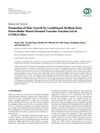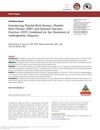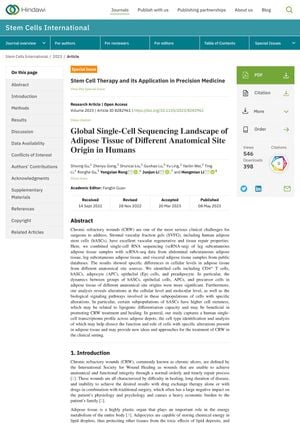TLDR Different parts of the body's fat tissue have unique cell types and characteristics, which could help treat chronic wounds.
The study used single-cell RNA sequencing to analyze adipose tissue samples from different anatomical sites, identifying specific cellular differences and dynamics between groups of cells. Ten separate cell types were identified, each with unique characteristics and involvement in metabolism-related pathways. The study also revealed alterations at the cellular and molecular level, including in biological signaling pathways. Some subpopulations of human adipose stem cells showed higher cell stemness, potentially beneficial for treating chronic refractory wounds. The data can be a valuable resource for constructing a human single-cell transcriptome atlas across adipose depots, aiding in understanding the function and role of cells with specific alterations in adipose tissue. However, the authors suggest that a larger number and diversity of adipose tissue samples should be collected for future studies.
1425 citations
,
September 2020 in “Open Biology” Better understanding of wound healing is needed to develop effective treatments for chronic wounds.
 13 citations
,
June 2020 in “Stem Cells International”
13 citations
,
June 2020 in “Stem Cells International” A substance from a specific gel helped to grow hair effectively in mice, suggesting it could potentially be used to treat hair loss in humans.
48 citations
,
March 2020 in “Stem Cell Research & Therapy” Using a collagen sponge scaffold helps stem cells become more like skin cells.
263 citations
,
February 2020 in “International journal of molecular sciences” ADSCs help in wound healing and skin regeneration but need more research for full understanding.
 40 citations
,
March 2018 in “Aesthetic Surgery Journal”
40 citations
,
March 2018 in “Aesthetic Surgery Journal” New treatment combining PRP and SVF increases hair density in 6-12 weeks for androgenetic alopecia patients.
6 citations
,
September 2021 in “Autophagy” Autophagy prevents early aging and maintains lipid and pheromone balance in mouse glands.
42 citations
,
July 2021 in “Frontiers in Cell and Developmental Biology” Oral mucosa heals with minimal scarring, offering insights for scarless wound healing.
346 citations
,
April 2020 in “Frontiers in Oncology” EMT and metabolic pathways help cancer cells resist treatment and spread.
18 citations
,
April 2016 in “The journal of immunology/The Journal of immunology” Thymic mesenchymal cells have unique gene expression that supports their specific functions in the thymus.
 1 citations
,
September 2023 in “Stem cell research & therapy”
1 citations
,
September 2023 in “Stem cell research & therapy” Mesenchymal stem cells could help treat aging-related diseases better than current methods.




